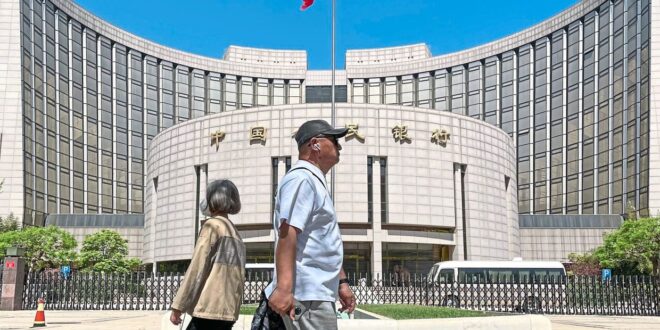CHINA”s central bank is set to leave a key policy rate unchanged when rolling over maturing medium-term loans on Monday, a Reuters survey showed, while a vast majority of respondents also expect some liquidity to be drained via the bond instrument.
Market watchers widely believe Beijing will continue to prioritise the stability of the yuan, at a time the Chinese currency is facing renewed depreciation pressure. It weakened to a five-month low this week, dragged down by a resurgent U.S. dollar.
In a Reuters poll of 31 market watchers conducted this week, all respondents expected the People’s Bank of China (PBOC) to leave the interest rate on one-year medium-term lending facility (MLF) loans unchanged at 2.50% when rolling over 170 billion yuan ($23.49 billion) worth of such loans.
Among them, 24, or 77% of all participants expected the central bank to partially roll over the maturing loan. Another four respondents forecast a full rollover, while the remaining three predicted the PBOC to inject fresh funds exceeding the maturity.
The strong consensus on steady MLF rate comes amid rising yuan depreciation pressure amid a still-shaky domestic economic recovery and push back of market expectations around the timing of a first Federal Reserve interest rate cut this year.
That has in turn maintained a wide U.S.-China yield gap, giving yuan bears the upper hand.
“The PBOC appears to be favouring utilising reserve requirement ratio (RRR) cuts over interest rate cuts to support the economy, as RRR cuts will not add to yuan depreciation pressure while a rate cut would worsen already unfavourable yield spreads,” said Lynn Song, chief economist for Greater China at ING.
“As such, next week’s medium-term lending facility rate decision is likely to see the PBOC standing pat,” he said, adding that he expects the central bank to cut the MLF rate twice with 10 basis points each this year.
The PBOC lowered the MLF twice by a total of 25 basis points in 2023 to shore up a stuttering recovery in the world’s second-largest economy. But widening yield differentials with other major economies have constrained the central bank’s scope to ease further.
Separately, signs of loosening in cash conditions are expected to reduce the demand for the central bank’s medium-term loans, traders said, prompting a possible liquidity withdrawal from the banking system.
The interest rate on one-year AAA-rated negotiable certificates of deposit (NCDs), which measures short-term interbank borrowing costs, has been consistently trading lower to hit 2.1352% this week, the lowest level since November 2022.
NCDs has been a popular short-term debt instrument used by financial institutions in the interbank market for financing.
“Yields on longer-dated government bonds are at low levels, and as NCD rates have been falling to be significantly lower than the MLF rate, these will inevitably weaken the attractiveness of MLF funds,” said Zhou Maohua, a macroeconomic researcher at China Everbright Bank. – Reuters
 BeritaKini.biz Berita Viral Terkini di Malaysia
BeritaKini.biz Berita Viral Terkini di Malaysia





